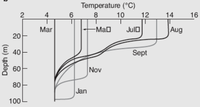
Photo from wikipedia
Statistical properties of near-surface horizontal velocity gradients are obtained from four drifter experiments conducted in the Gulf of Mexico during Summer 2012 and Winter 2016. The data density provided by… Click to show full abstract
Statistical properties of near-surface horizontal velocity gradients are obtained from four drifter experiments conducted in the Gulf of Mexico during Summer 2012 and Winter 2016. The data density provided by the near-simultaneous deployments of 90-326 surface drifters in each allows direct, drifter-based estimates of the scale dependence of velocity gradients at separation scales ranging from 200 m to 5 km. The robustness of these estimates, derived from uniquley sampled, nearly equilateral triplets, is confirmed by comparisons with estimates produced from larger drifter clusters, and with estimates based on concurrent Eulerian X-band radar observations. The winter launches were deployed above a ∼80 m deep mixed layer, one in a region with nearly homogeneous horizontal density structure, the other in a region of strong surface density gradients associated with filaments of fresh Mississippi River water. The summer launches occurred in a shallow (10m) mixed layer, one launched across a mesoscale frontal jet separating regions of horizontally homogeneous density and the other, similar to the corresponding winter launch, also in a region filamented by shallow lenses of cold, fresh water. Seasonal differences are observed, with larger velocity fluctuations and greater variance in divergence and vorticity, especially at the smallest scales, in winter. Differences between same-season launches are, however, as large as seasonal differences. In both seasons, observations sampling regions directly impacted by fresh water fluxes show strongly skewed vorticity distributions, with cyclonic vorticity dominating strain. For the other launches, one in each season, strain dominated minimally skewed vorticity. Plain Language Summary Variations in the near-surface currents act to redistribute floating material in the ocean. While much is known about variations at large scales, 50–100 km, the statistics of surface currents at smaller scales, 100m-10km, are not nearly as well documented. Here observations provided by hundreds of satellite-tracked drifting instruments (drifters) are used to measure such statistics in four distinct experiments, two each in summer and winter. The large number of drifters in each case allows us to determine, with a new level of statistical certainty, how surface current properties vary on scales ranging from 200 m to 5 km and provides benchmark observations of seasonal and spatial variability. Supporting observations of the upper-ocean density structure allows investigation of this impact on small-scale currents. Higher variability occurs in the more energetic winter flows, as expected. However, differences between two launches within a single season are equally large. Similarities between two flows, occurring in different seasons, can be traced to the presence of fresh, Mississippi River water in each. The drifter estimates were found to be consistent with measurements derived from a completely independent set of observations (surface radar images) indicating the potential for measuring near-surface current variations with large numbers of relatively inexpensive drifters.
Journal Title: Journal of Geophysical Research
Year Published: 2020
Link to full text (if available)
Share on Social Media: Sign Up to like & get
recommendations!